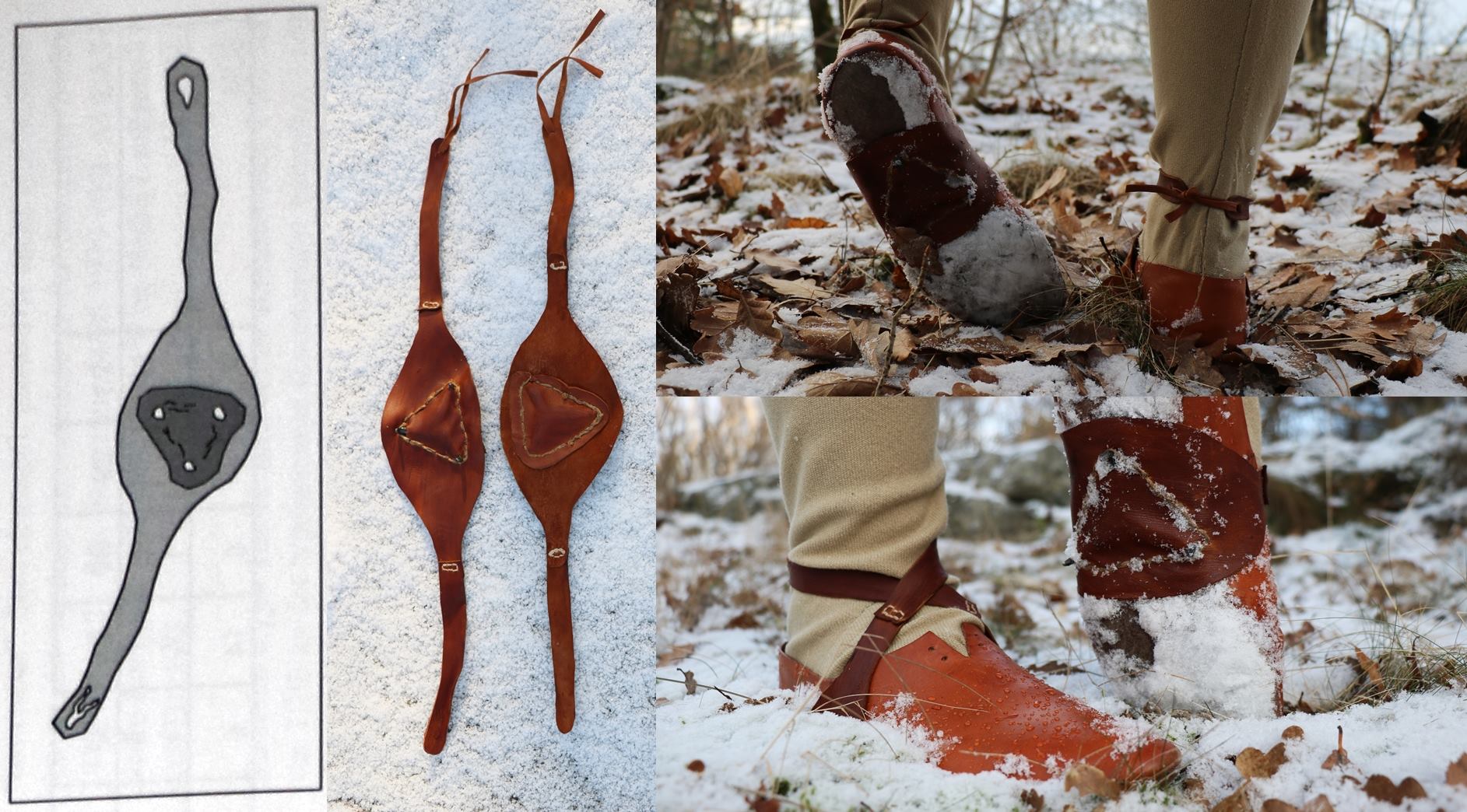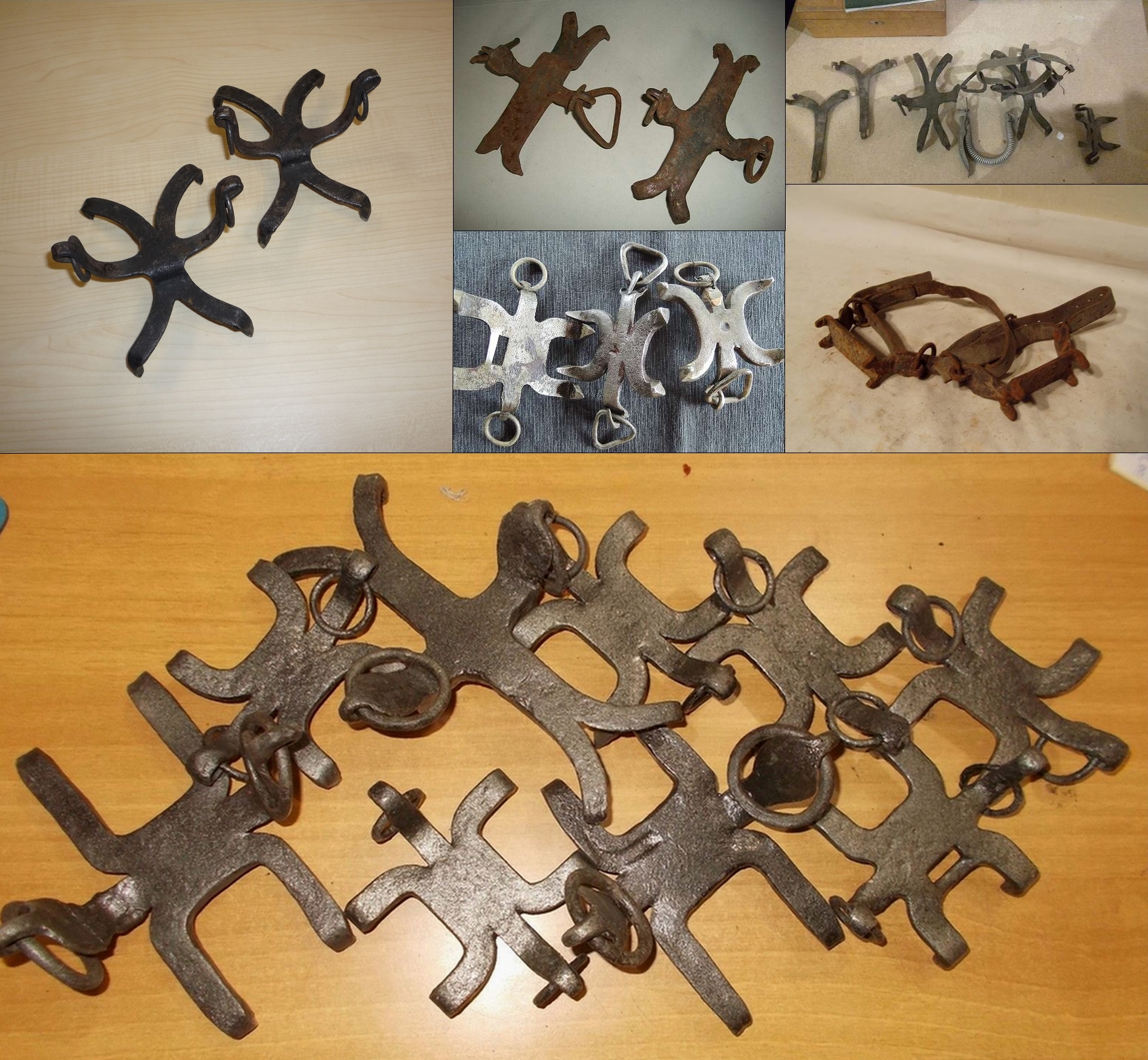For my entire reenactment career, I have encountered the problem of slippery shoe soles. Some reenactors solve the problem with rubber soles or metal hobnails, but these are not period solutions. Leather soles are extremely slippery on the wet or frozen surfaces, especially when they are a bit used and scuffed, which means the problem has to be solved in a way.
In Sagas of Icelanders and some other sagas, two terms skóbroddr (“shoe spike”; Eyrbyggja saga, Sturlunga saga, Sverris saga) and mannbroddr (literally “man’s spike”; Þorsteins saga hvíta, Vápnfirðinga saga) occur and they represent spikes that are used when saga heroes travel over the ice or as a cheating device mounted to horse forehead during horse fights. Spikes were not permanently attached to shoes; one could put them on and take them off as needed.
Crampons from sagas have many counterparts in the archaeological material in the whole of Scandinavia and beyond. The term mannbroddr suggests there were also crampons designed for horse hooves (see here). In some cases, it is difficult to determine which crampons were designed for men and which for horses. In this article, we will focus mainly on crampons that were meant to be attached to shoes. We will look at finds from Birka and Haithabu and some other analogies. Their function is to help to get stability on slippery surfaces, mainly ice. Etnographical mentions even attest the usage of crampons by whalers on the ocean, where whales were butchered (Goubitz 2007: 305). It is important to add that some of the graves with crampons from Birka were interpreted as winter graves; crampons and skates could play a symbolic role in this case (Gräslund 1980: 75–76). Fox example, during the exhibition We call them Vikings, The Swedish History Museum in Stockholm described crampons with these words: “The road to Hel is icy and leads north and downwards. Ice spikes ensured a safe arrival.“
Here are links to downloadable documents I prepared for you:
Swedish crampons (including Birka type 1, 2 and 3)
Crampons from Haithabu
Generally speaking, crampons of the Viking Age had no more than four spikes. Spikes are positioned in the way to maximize the friction of the shoe. Crampons can be divided into four basic categories:
- Type A, “1-point crampons”. These were made of separate bent bands with only one spike. Bent bands, with no more than three pieces at the same time, were attached to leather or wooden bases. The length of these bases corresponded with the width of the shoes and were connected by straps to the shoe. Birka types 1 and 2 belong to this type (Arwidsson 1986: 111; however, Birka type 2 crampons could be horse crampons; discussion with Sergey Kainov). This type occurs also in Norway (Petersen 1951: 62–63), Latvia, Slovakia (my personal observations) and on territories of the Old Rus (Kainov–Spasov 2005),
- Type B, “3-point crampons”. Crampons of this type are in forms that are roughly trianglar – crampons in the shape of an equilateral triangle with open inner space (Birka type 3), Y-shaped crampons (Haithabu types 1 and 2), T-shaped crampons (Haithabu type 3) and V-shaped crampons (Swedish type 5). Crampons in the shape of an equilateral triangle with open inner space have been found in Norway, Sweden, Iceland, Poland, Latvia and Old Russia (Petersen 1951: 62–63; Arwidsson 1986: 111; Kirpičnikov 1973: 170; Kainov–Spasov 2005; Petrov 2006: 174; Wojtasik 1998: 372, Ryc. 10.27,5). Y-shaped crampons were found not only in Haithabu, but also in Schleswig (Saggau 2000: 99–100), in territories of West Slavic tribes and in Lund (Westphalen 2002: 271), in medieval Söderköping (SHM 34183:23), in medieval Riga (Petrov 2005) and Novgorod (Petrov 2006: 173–174); the same pieces were found in the tool chest from Mästermyr, Gotland (Arwidsson–Berg 1999: 16, No. 92–93). Three T-shaped crampons were found in Haithabu (Westphalen 2002: 271). V-shaped crampons were only found in the grave Valsgärde 7, which dates to the 7th century (Arwidsson 1977: 91, No. 1097; Arwidsson 1986: 112). No sure method of attachment is known, but we are aware of several high medieval or early modern methods from Oslo, Tønsberg, Trondheim, Leiden, Riga and Novgorod:







Proposed reconstruction of crampon fixing to the sole through two notches. Find from Szczecin, 12th century. Source: Dworaczyk et al. 2003: 24.



- Type C, “4-point crampons”. Three X-shaped crampons were found in Haithabu (Haithabu type 4; Westphalen 2002: 271). In Viking Age and medieval Norway, X-shaped crampon with open inner space were used as well (see C13709, C35607, C37183 or T2316). Similarly, there is a X-shaped crampon with open inner space and metal holders found in medieval Hovgården, Sweden (SHM 15825:149). The attachment method is not known from the Viking Age and it could be similar to what we have shown in the case of type B.

- Other types, “atypical crampons”. We have to mention crampons of the Swedish type 4, that were found in graves Tuna Alsike X and Bengtsarvet 2. They were made of an iron bands, whose length corresponded to the width of the shoe. They had bent ends with loops for attachment and three spikes on the bottom side. Analogical methods with two spikes were found in late medieval or early modern sites from Germany (Heiligenberg, Tannenberg, Dossenheim, Gaisberg; Gross 2012: 448–9) and Russia (Staraya Ladoga). Besides the find from Staraya Ladoga, Kirpichnikov (1973) shows yet another interesting form medieval.

Viking Age crampons could seem as old-fashioned or primitive pieces of metal. However, in Europe, simple crampons like all those aforementioned were used until the 20th century. Their simple and effective construction uses only a limited number of variants. Therefore, we can see very similar pieces in space and time.
Firsthand experience
My first chance to use crampons took place in 2015, during the festival of Libušín, in the Czech Republic. I chose crampons of type B (Haithabu type 2, Y-shaped). I am very indebted to Jiří “Link” Novák, who gave them to me as a gift. The attachment method was copied from Danish reenactors, since I had not the sources I have now. This was my first try and I would like to inform you about all pros and cons of this piece of gear.
The most important discovery of this experience was that crampons make shoes a very useful thing. When a crampon is used with leather soled shoes, the result is comparable with rubber sole or hobnails. I have not had a chance to use crampons on an icy surface, but they worked perfectly on the wet or dry grass and were very useful during climbing a hill. I used crampons with thick felt insoles, but I think that woolen insoles and crampons fixed with the second layer of leather can lead to the same comfortable feeling. When the user is careful and slow, crampons can be even used on hard surfaces for short distances (all you feel is the pressure). In battle, crampons are also useful for stability, but rather dangerous and therefore not recommended. I personally think they were used mainly in winter, while they had no benefit in summer. They should be used mainly during winter events (for example hikes), whereas to a limited extent during summer events.
The first try showed that a crampon should be fixed into two layers of leather, because the crampon has a tendency to move and to tear the leather.For the same reason, it is necessary to place the crampon the middle of the leather band, not near the edge. The stitching can be very useful. It is always better have two fixed points on the shoe; my attachment method took advantage of leather straps, which hold the leather band in place. Below, you can have a look at photos of my experience.










I hope you liked reading this article. If you have any question or remark, please contact me or leave a comment below. If you want to learn more and support my work, please, fund my project on Patreon.
Bibliography
Arwidsson 1977 = Arwidsson, Greta (1977). Valsgärde 7, Lund.
Arwidsson 1986 = Arwidsson, Greta (1986). Die Eissporen. In: ARWIDSSON, Greta (ed.) Birka II: 2. Systematische Analysen der Gräberfunde, Stockholm: 111–112.
Arwidsson–Berg 1999 = Arwidsson, Greta – Berg, Gösta (1999). The Mästermyr find : a Viking age tool chest from Gotland, Lompoc.
Brendalsmo – Lindh 1982 = Brendalsmo, Jan – Lindh, Jan (1982). Funn fra en utgravning, Øvre Ervik.
Dworaczyk et al. 2003 = Dworaczyk, Marek et al. (2003). Szczecin we wczesnym średniowieczu. Wschodnia część suburbium, Szczecin.
Færden et al 1990 = Færden, G., Schia, E., Molaug, P. B. (1990). De Arkeologiske utgravninger i Gamlebyen, Oslo. 7-8, Dagliglivets gjenstander, Øvre Ervik.
Goubitz 2007 = Goubitz, Olaf (2007). Stepping through time : archaeological footwear from prehistoric times until 1800, Zwolle.
Gräslund 1980 = Gräslund, Anne-Sofie (1980). Birka IV. The Burial Customs. A study of the graves on Björkö, Stockholm.
Gross 2012 = Gross, Uwe (2012). Die mittelalterlichen und neuzeitlichen Keramik-, Metall und Beinfunde. In: Gross, Uwe et al. Forschungen zum Heiligenberg bei Heidelberg : Forschungsgeschichte, Fundmaterial, Restaurierung (Forschungen und Berichte der Archäologie des Mittelalters in Baden-Württemberg, Bd. 32), Stuttgart: 393–563. Available here.
Johansen 2008 = Johansen, Lise-Marie B. (2008). Arkeologisk overvåkning av arbeidene med ny E18 Senketunnel på Sørenga. Del 1, Tekst. NIKU Rapport Arkeologiske Utgravninger 2008/57. Revisjon nr. 01.
Johansen – Molaug 2008 = Johansen, Lise-Marie B. (2008). Arkeologisk utgraving ved bygging av ny E18 Senketunnel på Sørenga. Sjø- og elveavsatte lag fra middelalder. Del 1, Tekst. NIKU Rapport Arkeologiske Utgravninger 2008/56. Revisjon nr. 01.
Kainov–Spasov 2005 = Сергей Каинов – Федор Спасов (2005). Обувные шипы. Исторический экскурс и практическое применение. Online: http://asgard.tgorod.ru/libri.php3?cont=_brodd
Kirpichnikov 1973 = А. Н. Кирпичников (1973). Снаряжение всадника и верхового коня на Руси IX—XIII вв, Ленинград.
Petersen 1951 = Petersen, Jan (1951). Vikingetidens Redskaper, Oslo.
Petrov 2005 = М. И. Петров (2005). Еще раз об обувных шипах. Online: http://asgard.tgorod.ru/libri.php3?cont=_brodd1
Petrov 2006 = М. И. Петров (2006). Обувные шипы из новгородских раскопок // Новгород и Новгородская земля: история и археология : материалы науч. конференции. Новгород, 24-26 янв. 2006 г, Великий Новгород: 171–178. Online: http://bibliotekar.ru/rusNovgorod/144.htm
Rybakov 1985 = Рыбаков, Б. А. (1985). Археология СССР : Древняя Русь. Город, замок, село, Moskva.
Saggau 2000 = Saggau, Hilke E. (2000). Mittelalterliche Eisenfunde aus Schleswig : Ausgrabung Schild 1971-1975, (Ausgrabungen in Schleswig 14), Neumünster.
Sirelius 1934 = Sirelius, U. T. (1934). Die Volkskultur Finnlands : I. Jagd und Fischerei, Berlin-Leipzig.
Schietzel 2014 = Schietzel, Kurt (2014). Spurensuche Haithabu, Neumünster / Hamburg.
Ulriksen 1992 = Ulriksen, Eli. Lærmaterialet. In: Lindh, Jan (1992). Arkeologi i Tønsberg. 1 : Søndre bydel, Oslo: 103–142.
Westphalen 2002 = Westphalen, Petra (2002). Die Eisenfunde von Haithabu, (Die Ausgrabungen in Haithabu 10), Neumünster.
Wojtasik 1998 = Wojtasik, Jerzy (1998). Srebrne Wzgórze w Wolinie, wstępne wyniki badań z lat 1961–1969. In: Materiały Zachodniopomorskie, 45, 321–383.













4 Responses
Excellent article! Just wondering if you have ever come across any examples of shoe Pattens from the 9th or 10th century? I can only find middle ages examples. A few of the sites we do SCA activities are incredibly muddy. The Crampons would definitely help with traction but the turn shoes becoming saturated in mud is hard to avoid. Have you heard of a period correct solution to this problem?
Hello, your question has been answered in an email.
Thank you very much for your impressive work and thorough bibliographic links. Even when I ‘merely’ use it for verisimilitude in tabletop role playing games, things like this matters.
Thank you very much!